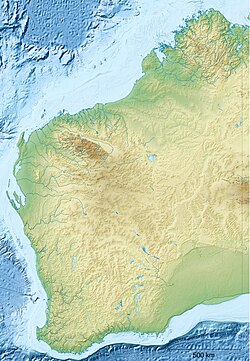| Newmarracarra Limestone | |
|---|---|
| Stratigraphic range: Late Bajocian ~ | |
| Type | Geological formation |
| Unit of | Champion Bay Group |
| Underlies | Kojarena Sandstone |
| Overlies | Colalura Sandstone, Bringo Shale |
| Lithology | |
| Primary | Limestone |
| Other | Sandstone |
| Location | |
| Coordinates | 28°42′S114°48′E / 28.7°S 114.8°E |
| Approximate paleocoordinates | 40°06′S57°30′E / 40.1°S 57.5°E |
| Region | Western Australia |
| Country | Australia |
| Extent | Perth Basin |
The Newmarracarra Limestone is a Bajocian geologic formation, in Western Australia. It consists of yellow grey sandy or clayey limestone, which occasionally grades into calcareous sandstone. [1] Fossils of the Rhynchonellida in the family Wellerellidae, Cirpa fromontae were reported from the formation. [2]

